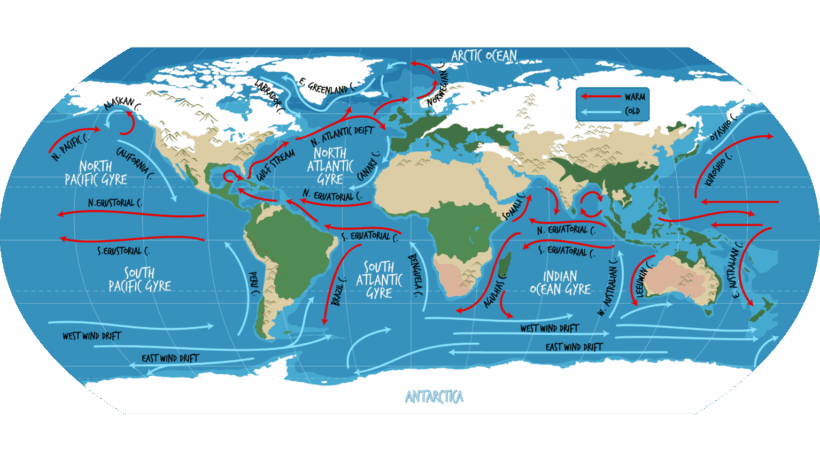Ocean circulation is not merely a vast dance of water across planetary scales; it is an intricate symphony of interwoven currents, tides, and thermal dynamics that dictate the very fabric of Earth’s climate. Just as a conductor guides an orchestra to produce harmonious sounds, the ocean’s circulatory systems orchestrate climatic patterns, affecting weather, temperatures, and even biodiversity. Understanding these forces offers profound insight into the challenges we face in an era of climate change.
At the core of this dynamic system lie ocean currents—vast rivers of water moving through the deep blue. These currents, driven by wind patterns, the Earth’s rotation, and differences in water density, facilitate the redistribution of energy across oceans. Warm water from the equator travels poleward, while cold currents flow towards the equator, creating a complex and continuous exchange. This movement is akin to the circulatory system in our own bodies, channeling vital nutrients while regulating temperature.
Consider the Gulf Stream, an iconic current that meanders from the Gulf of Mexico along the eastern coast of the United States and across the Atlantic to Western Europe. It serves as a conveyor belt, transporting warm tropical waters to higher latitudes. This flow has a remarkable effect on climate, making regions such as the British Isles and Scandinavia significantly milder than they would otherwise be. Thus, ocean currents are not just water moving from point A to point B; they are climate architects sculpting ecosystems and weather patterns far afield.
Sea surface temperatures play a pivotal role in dictating these currents. When the sun’s rays warm the surface waters, especially during summer, the temperature differential creates wind patterns that further enhance surface currents. The interplay between temperature and circulation can lead to phenomena such as El Niño and La Niña, which alter global weather phenomena, bringing droughts, floods, and shifts in biodiversity. The ocean’s surface acts as a temperature regulator, absorbing excess heat and mitigating temperature spikes on land.
Tides, too, contribute to this orchestration. While often perceived as simple rises and falls influenced by the moon and sun, they are vital in mixing ocean waters and, by extension, facilitating nutrient transfer in marine environments. Tidal forces generate a rhythm, harmonizing with the internal clock of numerous marine species, influencing spawning, migration, and feeding. Moreover, tidal currents interact with larger currents, enhancing vertical mixing and ensuring nutrient availability at various depths. This symphony of movement underpins marine ecosystems, reinforcing the connection between ocean health and climate stability.
Yet the very mechanisms that sustain climate are under threat. Anthropogenic activities have altered the delicate balance within these systems. Global warming, driven by fossil fuel combustion, releases vast amounts of greenhouse gases into the atmosphere, resulting in rising sea temperatures. Warmer waters can hold less dissolved carbon dioxide, leading to increased acidity—a phenomenon known as ocean acidification that adversely affects marine life and disrupts food webs.
The melting polar ice caps and glaciers, resulting from escalating temperatures, are further destabilizing the ocean’s conveyor belts. As freshwater enters the salty oceans, it disrupts the density gradients that fuel major currents like the Atlantic Meridional Overturning Circulation. This alteration has alarming implications, potentially leading to abrupt climatic shifts. Scientists warn that if the Gulf Stream weakens significantly, Europe could experience severe winters while tropical regions could face intensified storms, epitomizing the unpredictability of climate change.
Moreover, the interplay between ocean circulation and the hydrological cycle is ever more pronounced. The oceans are the planet’s largest reservoir of water vapor, and changes in circulation patterns can exacerbate rainfall distribution. Increased evaporation from warmer oceans can lead to more intense storms, as evidenced by the rising frequency of hurricanes and cyclones. These weather extremes wreak havoc on coastal communities, agriculture, and ecosystems, highlighting the vulnerability inherent in our interconnected systems.
Despite the dire implications of disturbed oceanic systems, there is hope. The ocean holds potential solutions to combat climate change. Ocean-enhancing strategies include restoring mangroves, seagrasses, and coral reefs, which serve as natural carbon sinks. These biomes not only absorb carbon dioxide but also provide resilience against storm surges and coastal erosion. There is a growing movement towards marine protected areas (MPAs) which can bolster biodiversity and enhance the resilience of marine ecosystems in the face of global change.
Furthermore, understanding ocean circulation can inform climate models, helping us predict future weather patterns and environmental changes with greater accuracy. These insights are critical for crafting effective policy responses to climate change, ensuring that we manage our oceans with the care they require. There is an urgent need for international collaboration to safeguard our oceans and the myriad climates they influence since the challenges posed by climate change require collective action.
In conclusion, ocean circulation is a complex, dynamic system vital to regulating global climate. It acts not only as a conveyor of temperature and nutrients but also as a sentinel of change, reflecting the health of our planet. The echoes of its movements reverberate through climate systems, and our understanding of these mechanisms will dictate our ability to combat the unfolding climate crisis. Effective stewardship of ocean resources emerges as a pivotal imperative, a clarion call for action in our shared quest for environmental sustainability.







